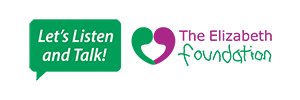Foundations for communication
Tips, advice and guidance from The Elizabeth Foundation to help young deaf children develop their listening and talking skills.
A launchpad for language
How to build your deaf baby’s listening, communication and language skills
Deaf children – just like any other children – are keen to communicate and interact as soon as they are born.
In this article, we will explain how to put into place the four building blocks your deaf baby needs for their future communication development:
- Good listening skills and effective hearing technology form the crucial starting point
- Early nonverbal communication skills underpin and support the development of language – babies use sounds, movements and facial expressions to let us know how they feel.
- Understanding language is the crucial next step (also known as receptive language)
- And finally, using language: progressing from cooing and babbling to using first words (expressive language)
Learning to listen and listening to learn
Good listening skills are a fundamental first step for spoken language development. But they can take a lot of practice to develop, especially for a child who is deaf.
You can help your baby learn to listen and listen to learn in many ways. As well as using your voice, you can point out sounds around you that happen every day and highlight differences between sounds to help your baby recognise them.
However, for deaf children, consistent use of effective hearing technology (usually hearing aids for younger babies) is crucial – so we will start by taking a look at ways to achieve this goal.
Hearing technology unlocks the world of sound
Soon after your baby’s deafness was identified, he/she will probably have been fitted with digital hearing aids. These amazing little pieces of advanced electronic technology help your child access sounds more effectively. Some children will continue using hearing aids as they grow older; others may be offered cochlear implants from around 1 year of age if appropriate for the nature/cause of their deafness.
It can take a while for both you and your child to get comfortable with using hearing aids. If you are like most other parents of deaf babies, this will be the first time you will have encountered these devices. Now your child has been given his/her hearing aids, you will probably have many questions, such as:
How do I make sure the hearing aids are working properly? How do I fit the hearing aids to my baby? How often and for how long should my baby wear his/her hearing aids? And, last but not least, how do I keep my baby wearing the hearing aids?
Daily listening checks and maintenance
Your child’s hearing aids will only enable him/her to access sound if they are working correctly, enabling them to access the range of speech sounds needed to learn language. So, it is important to get into a regular habit of completing a hearing aid check routine at the start of each day (see box).
Don’t worry if this all seems a bit complicated and time-consuming at first – it will soon become second nature and take no time at all!
Achieving full-time hearing aid use
Like checking them, putting in your child’s hearing aids is a skill that you might find a bit tricky at first but you will get the knack with practice.
The goal is to have your baby wearing his/her hearing aids all day everyday as they get older, but this won’t happen overnight! The best advice we can offer is to introduce your baby to his/her hearing aids with short, sharp bursts of hearing aid use over several weeks/months – be patient and persistent, and take your time.
To start with, aim for your child to wear his/her hearing aids short, sharp bursts throughout the day. Select your times carefully and prepare ahead to keep him/her distracted and engaged by your voice, games, musical toys and other noisemakers.
As your baby gets older, and as the amount of time he/she is alert and awake increases, try to lengthen the amount of time your baby is wearing hearing technology. Your end goal is for your baby to be wearing his/her hearing aids for most of the waking day.
Keeping the hearing aids in!
At some point in their early years, your child will almost certainly realise how to pull out his/her hearing aids. You’ll be relieved to learn that this is a common phase that deaf children pass through.
For some children this stage can seem to last quite a while but it doesn’t last forever – even though it might seem like it at the time! It is normal to think that you will never get past it, and that your child hates their aids or something is wrong. We would like to reassure you that in time, and with you persisting, your child will tolerate his/her hearing aids and wear them most of the time his/her waking hours.
Early listening activities
Hearing babies usually progress through the “listening hierarchy” (see box), without any conscious effort on their parents’ part, just by encountering the sounds and day-to-day conversations all around them.
With appropriate hearing technology, children with any degree of deafness will be able to start accessing everyday sounds and move through these stages. However, they will need more input and persistence from their parents to help them become aware of different sounds and what they mean. This involves not just talking and singing to your baby so he/she hears your voice, but also pointing out sounds all around you and making listening a fun and exciting experience.
Activities to develop your baby’s listening skills
The following suggestions are intended to be a starting point – you can find more listening activities in the Let’s Listen and Talk baby programme.
Before starting any of these activities, create a good listening environment by minimising competing sounds, such as the television, radio, or other distractions.
- Play calling games – call your baby before he/she can see you and then call again once you have eye contact; call between mummy and daddy.
- Notice and enjoy the different types of sounds around the house – point out things that make noise such as the vacuum cleaner, telephone, running tap, toast popping out of the toaster, the front door bell, flush of the toilet – as well as outdoor sounds such as cars, buses, lorries, sirens, helicopters, car horns, etc.
- Enjoy sounds that are high-pitched (bell), medium-pitched (shaker) and low-pitch (drum) – explore sounds with your senses – see it, feel it, hear it!!
- Listen for quiet sounds and loud sounds.
- Dance together to music:
- move in different ways to different music: sway to slow tunes; bop to fast tunes
- help your child realise that sounds start or stop by turning off the music, keeping still and listening to the silence, then turning on the music and starting to dance again
- Sing nursery rhymes with lots of gestures and actions.
Nonverbal communication – getting a message across without using words
Right from the start, babies are communicating. Before they use sounds and words, babies use sounds, movements and facial expressions to tell us how they feel. Babies coo, cry, gurgle, smile, frown, wiggle, kick their legs and flail their arms.
At the same time, they are watching for their parent’s facial expressions and other nonverbal signals. These shared nonverbal “conversations” make it possible for parents and their babies to communicate with each other.
Nonverbal “conversations” start from birth
Most infants use and respond to nonverbal communication. This means they can take part in “conversations” almost from birth. You can help your baby to become a good nonverbal communicator by closely observing their nonverbal signals, and giving him/her plenty of time to respond to your actions and expressions. These early communication skills are crucial because they underpin future language development.
To start with, your baby may not understand the words you are saying, but at a very basic level, he/she understands the expression on your face as you talk and your gestures and body movements. He/she can tell if these nonverbal signals mean you are happy, angry or sad and will respond accordingly.
Communication involves “speakers” and “listeners”
Babies learn quickly that communication is a two-way street. When you speak or use facial expressions, your baby will watch intently. You are the “speaker” and he/she is the “listener”. When you stop talking and just look expectantly, your baby may begin to gurgle and smile. This might be accompanied by wiggling or by waving of arms. Now your baby is the “speaker” and then you become the “listener.”
Just imagine what would happen if parents didn’t respond to their baby’s nonverbal communication. The baby, hearing or deaf, would think there was no reward for “talking.” They would soon “turn off” and their language development would be discouraged.
A baby begins to develop spoken language when an adult responds consistently to his/her nonverbal communication and when the baby is talked to. It is important to talk to all babies and engage them in conversations before they can use their own voice, but it is even more important to do this with children who are deaf.
Remember that language arises out of the need to communicate. A baby’s earliest demands revolve around satisfying his/her needs – usually centred around hunger, tiredness, companionship and comfort. When you respond quickly to your baby’s needs, you’re communicating back so your baby is able to learn the effects of his/her behaviour. By responding to your baby’s nonverbal messages such as looking, pointing and vocalising you will be helping your baby build bridges to verbal communication.
Practising nonverbal communication skills
You can help your baby develop their early nonverbal communication skills of eye contact, turn-taking, imitation and joint attention. The following suggestions are just a starting point – you can find more ways to build nonverbal communication in the Let’s Listen and Talk baby programme.
Eye contact
- Through eye contact, babies learn to use smiling, facial expression, tone of voice, body language and gesture as methods of communication.
- Get your baby’s attention before you start to talk.
- Hold a toy/object close to your face (being sure not to cover your mouth) and wait for him/her to look before you start to talk about the object.
- Give your baby eye contact when they are “cooing” and “talking” to you.
Imitation and turn-taking skills
- Imitation is a key learning strategy for all children in the early years.
- Physical imitation comes before speech and language imitation.
- Gestures are used before words develop – this broadens opportunities to communicate and learn language.
- Play imitation games such as clapping, tapping knees, tapping the floor, raising/lowering a shaker.
- You can later progress to imitation games that use speech – you say “ahhhh”, your child says “ahhhh”
Turn-taking
- Imitation can also help teach the “turn-taking” element of conversation and communication.
- Play any game where your baby has to watch others and wait for a turn – such as rolling a ball around a circle.
- Take turns in banging a drum/tambourine/ saucepan/high-chair tray.
Joint attention
- Joint attention is when two people are paying attention to the same thing, intentionally, and this encourages understanding of words.
- Name objects that your baby looks at or points to – notice what he/she interested in and talk to him/her about it.
- Follow your baby’s lead in play to increase opportunities for joint attention.
- Share and enjoy books together – pointing at pictures and naming what you can both see.
Understanding what words mean
Your baby needs to develop an understanding of what words mean (known as “receptive” language) before he/she is able to use these words (called “expressive” language). At this young age, your child will need to hear plenty of repetition of the same words and short phrases in day-to-day situations to develop their understanding and – eventually – be able to respond with his/her voice.
In the early stages of receptive language development, you can support your baby by talking to him/her about his/her environment and about what is catching his/her interest. Explain the things you are doing for your baby. That way, the meaning of the words you use over and over in the same situations will become meaningful to your baby more quickly than if you talked about things he/she does not know or things he/she cannot see.
Give words for what you think your baby is trying to say. Laughing, gurgling, crying, wiggling – your baby is communicating with you. Try to respond with words, for example if your child is sitting on the floor and looks at you raising their arms you can say, “Do you want me to pick you up? Up you come!”
Using everyday opportunities to develop your baby’s language
There is no better time to talk to your baby than when you are taking care of his/her needs. You have his/her undivided attention, and he/she have yours. When you are feeding, bathing, dressing or changing your baby, you are close to him/her so it is easy for your baby to see your face and hear your voice.
Routine activities such as eating/feeding, bathing/washing, changing nappies and so on, happen throughout the day, many times. So, this gives your baby the opportunity to learn about the words that go with these different activities.
Keep in mind that your baby is trying to communicate with you, too. Try to anticipate what your baby is trying to “say” to you. Always try to interpret his/her attempts at communication — such as facial expressions, gestures and body language. Respond appropriately with actions and words. Communication with your baby is a two-way street.
Ways to build language understanding
We will now take a look at ways you could talk to your baby during some typical everyday activities. Our suggestions should give you some idea about things you could say during these – and other – everyday activities.
Everyday activities provide an ideal opportunity for you to repeat the same words and short phrases in similar situations so your baby will gradually learn what they mean to develop their language understanding.
The following suggestions are intended to be a starting point – you can find more activities and ideas to build language understanding in the Let’s Listen and Talk baby programme.
- Say your baby’s name before you start speaking so that you have his/her attention.
- Get face-to-face with your baby so you can see and hear each other better.
- Talk about your everyday routines as you do them so that your baby is hearing the words in context: when he/she is feeding, getting dressed, having a bath, having a nappy change, when you are putting him/her into the pushchair/high chair/car seat, and so on.
- Repeat, repeat, repeat in natural ways – the more your baby hears a word, the more likely he/she is able to understand it, then use it.
- Pauses are powerful – give your baby time to process information and respond in whatever way he/she can.
- Follow your baby’s lead and talk about what your baby is looking at and interested in – give the words for the experience.
- Give choices – using the words as well as showing the choices.
- When offering toys, offer a choice such as, “Do you want the ball or the car?” Have both objects for your baby to choose from, and then name the one he/she selects.
- Use symbolic sounds with toys:
- symbolic sounds are short, easy sounds that represent something (e.g. a cow is a “moo” and a train is a “choo-choo”)
- common types of symbolic sounds include: animal sounds; transport sounds and everyday sounds (such as: “pop”, “mmmm”, “uh-oh”, “ow”, “yay”!)
- Play “What’s in the box?” or “What’s in the bag?” games to increase anticipation – take out each object and name it as your baby plays with it, and then name it again as you both put it back in the bag/box.
- Wave “Hello!” and “Bye-bye!” to people and toys, using the names of the people and toys as you do so – “Hello teddy!”; “Bye-bye duck!”; “Hello daddy!”
- Enjoy books together – talking about and naming what is in the pictures on each page.
- Take photos of familiar people and favourite toys – enjoy looking at the photos together, naming them as you go through the pictures.
- Music and nursery rhymes are great for developing understanding of words – especially ones with actions such as “Wheels on the bus”, “Head, shoulders, knees and toes”, “If you’re happy and you know it”, and so on.
- Brothers and sisters or other young relatives/friends are great fun and can be great role-models
Using words – expressive language
After identifying and understanding what words mean, your baby will begin to attempt to make sounds/words as part of his/her communication. This “expressive language” will enable your child to use words to make his/her wishes, needs and feelings known.
A child’s spoken language typically develops along the path shown in the “Spoken language development” box (shown below), but this process doesn’t take place in a step-by-step manner. The stages can run together, with some stages overlapping and occurring at the same time. Your baby will go through different stages of ‘expression’ before he/she has first words.
Activities to encourage expressive language
Early in infancy, babies who can hear take in some of the everyday conversations that goes on around them. A profoundly deaf baby may be less aware of the conversation that goes on around them in the beginning, but they can catch-up with good, consistent use of hearing aids/cochlear implants.
You should expose your baby to the everyday flow of natural language. Your baby will find it easier to detect words if the talking is directed at him/her and is near to their hearing technology. Use a voice that is full of intonation and expression. Most visual cues, such as facial expressions, are easier for your baby to see close up, too. Remember: Get close; get their attention; be natural, but animated.
Some useful tips and activities:
The following suggestions are intended to be a starting point – you can find more activities and ideas to build expressive language in the Let’s Listen and Talk baby programme.
- When your baby is awake, alert and wearing his/her technology, get in a good position to have a “chat”:
- face- to-face, with good eye contact, then imitate any sounds your baby makes, talk about what you think he/she might be saying;
- look expectantly at him/her for a vocal response and give enough time for that to happen.
- Let your baby know you are enjoying their sounds. This encourages your baby to continue to use his/her voice. Give him/her a smile, and imitate the sounds your baby makes. Your baby likes the sound and feel of his/her own voice and may imitate the sounds he/she sees, hears or feels.
- As you reinforce the sounds your baby is making, you may notice that these sounds are happening more frequently, or the vocalisations are becoming clearer.
- Your baby learns by watching, listening and socialising with other people – interact with your baby and enjoy your interactions! Always respond to your baby’s vocalisations / attempts to communicate.
- Talk to your baby about everything you are doing – most babies learn to talk because they are talked to and played with in meaningful contexts, like feeding, changing and dressing.
- Repeat phrases frequently in the same situations, so your child can make connections between words and actions.
- Once again, music and nursery rhymes are an invaluable route to expressive language:
- Sing nursery songs together, using lots of sound, gesture and actions, and giving your child plenty of time and opportunity to use his/her voice.
- Your baby may ask for a song using sound, gestures and/or action, so always respond if he/she does.
- Sing a familiar song and pause at the final word for your child to fill the gap.
- Play calling games and encourage your baby to ‘call’ in whatever way he/she can – call for mummy, daddy, a brother/sister, or particular toy.
- Hesitate in an activity to encourage your baby to make a request:
- For example, when blowing bubbles for your child, hesitate and see how your baby makes a request – looking, pointing, vocalising, word attempt – and once they have made a request, respond appropriately by blowing more bubbles.
- Respond to baby’s vocalisations by giving words:
- For example, your baby swipes all their food off the highchair tray with a big yell – you say, “You are finished, all done”.
- Help your baby learn how to express him/herself by giving your child the words for what they are trying to say.
- Take word attempts as true words:
- For example, if your baby is enjoying a game of bubbles and says “m-m-m”, respond by saying “You want more?”
- If your child says a word incorrectly, don’t correct him/her, but demonstrate the correct way of saying it:
- For example, you show your child a banana and he/she says “nanna”, you say “Yes, it is a banana.”
Remember: All children learn best when they are enjoying activities and are taking an active role in learning. The “tweaks” we suggest to everyday routines will support your child’s blossoming communication development and help them to learn all day, every day in very natural ways.

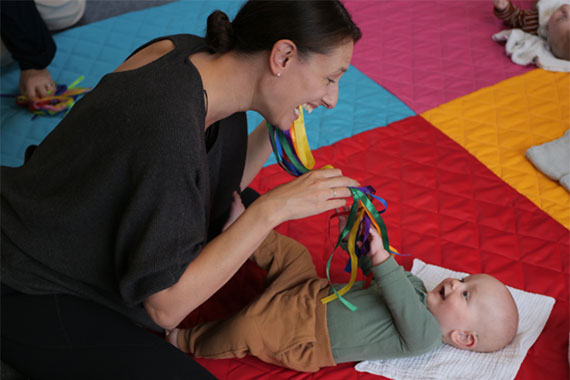
Summary - Creating a launchpad for language for your deaf baby:
- Whilst deaf babies follow the same path of language development as hearing children, their progress depends on consistent use of appropriate hearing technology combined with additional parental input.
- It is important to talk to all babies and engage them in “conversations” before they can use their own voice, but it is even more important to do this with children who are deaf.
- Your deaf baby will need to hear plenty of natural repetition of the same words and short phrases in day-to-day situations to develop their understanding and – eventually – be able to respond with his/her voice.
- There is no single approach that is “right” for all families, instead there is a variety of communication options to choose from: sign-based, listening-speaking based, and or a combination.
Let's Listen and Talk
The Let’s Listen and Talk – Getting to grips with technology and terminology course (requires free membership to access) provides more information about:
- maintaining hearing aids
- putting in hearing aids – and keeping them in!
- achieving full-time hearing aid use
To find out more visit: https://letslistenandtalk.org/lessons/learning-about-hearing-aids/ (requires free membership to access)
Daily hearing aid checks:
- Check the batteries are working – and replace or recharge if necessary.
- Examine the ear mould and tubing – and replace the tubing if necessary.
- Puff out any condensation – this will be less of a problem if you regularly put the hearing aids in a drying‑out pot at night.
- Listen to the hearing aid using the stetoclip or listening tube provided by your audiologist – using the Ling sounds: ah | oo | ee | ss | sh | mm
- Test the hearing aids when your child is wearing them – you should be able to notice a change in your baby’s behaviour/reactions when he/she is using them.
This video from the Let's Listen and Talk - Technology and Terminology course shows the key daily hearing aid checks.
What other parents say about hearing aids
In this video from the Let's Listen and Talk programme, parents talk about their child’s hearing aids (and how to keep them in!).
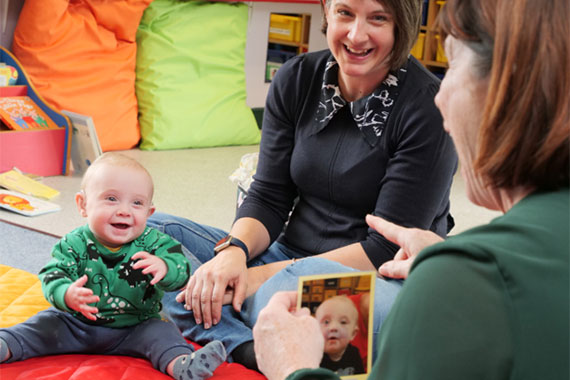
Listening hierarchy
Detection: an awareness of sounds
⇓
Discrimination: noticing differences between sounds
⇓
Identification: adding meaning to sounds
⇓
Comprehension: knowing that sounds/words have meaning
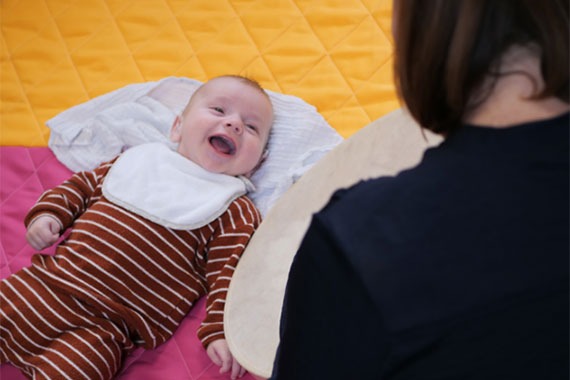
Early listening activities for your deaf baby
The Let's Listen and Talk Baby Programme provides further information and practical activities in the lesson Early listening skills – learning to listen and listening to learn [requires free registration]
For example, the following Listen and move activity:
- Click here to see the full instructions for this 'Listen and move' activity
Using music to help deaf babies develop language - useful links
Using music and nursery rhymes is an easy way to help your baby learn to listen. You can find music activities developed specifically for deaf babies here:
- Foundations for communication - Music matters
- Learning through music – Lets Listen and Talk
- BabyBeats (advancedbionics.com) – a series of music activities for deaf babies
Nonverbal communication activities
The Let’s Listen and Talk – baby programme [requires free registration] provides further information and practical activities for nonverbal communication in the lesson Early communication - talking without using words:
For example, the Making requests activity:
- Click here to see the full instructions for this 'Making requests' activity
Using sign language
The best communication approach for any deaf child and his/her family is the one which works for that child, fitting in with the family’s culture and values, and allowing the child to develop good self-esteem and positive self-image.
There is no single approach that is “right” or “best” for all families. Instead, there is a variety of communication options to choose from: sign-based, listening-speaking based, and / or a combination of the two.
Research evidence shows that learning sign language does not interfere with or preclude the development of spoken language, and can act as a bridge to talking. It can also become a preferred long-term communication method into adult life, especially with deaf peers.
If you wish to use sign language with your child, you can make a start by adding some key signs into the receptive/expressive language activities in this article.
On our website you can find videos showing a wide range of British Sign Language (BSL) signs for the early years.
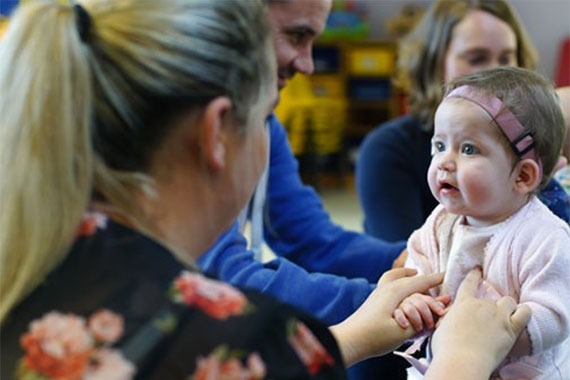
Activities to develop language understanding
The Let’s Listen and Talk – baby programme [requires free registration] provides further information and practical activities in the lesson Everyday language during everyday activities [requires free registration]
For example, this Talk and do activity:
- Click here to see the full instructions for this 'Talk and do' activity
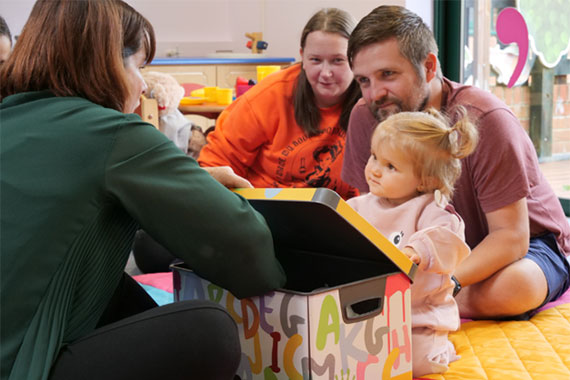

Spoken language development
Crying: the earliest expressions to indicate wants and needs
⇓
Cooing: soft, vowel-like sounds used to communicate
⇓
Nonverbal communication: using nonverbal communication – such as gesturing, facial expressions, pointing, tugging, reaching
⇓
Taking turns: during activities and also in early nonverbal “conversations”
⇓
Vocalising and then combining vocalisations with gestures and pointing
⇓
Babbling: combinations of consonants and vowels (eg “ba”, “ma”, “pa”); your baby is experimenting with voice and communicating even though unable to say words
⇓
Using “jargon”: babbling with meaningful stress and intonation; telling a story with no words; singing a song with no words
⇓
Understanding first words
⇓
Attempting first words: trying to say first words (“mmm” for “mama”, “ba” for “bottle”
⇓
Saying single words spontaneously
⇓
Using two words together: such as “Want milk” or “Go bye-bye”
Activities to develop expressive language
The Let’s Listen and Talk – baby programme [requires free registration] provides further information and practical activities in the later lessons.
For example, this Story time activity:
- Click here to see the full instructions for this 'Story time' activity


